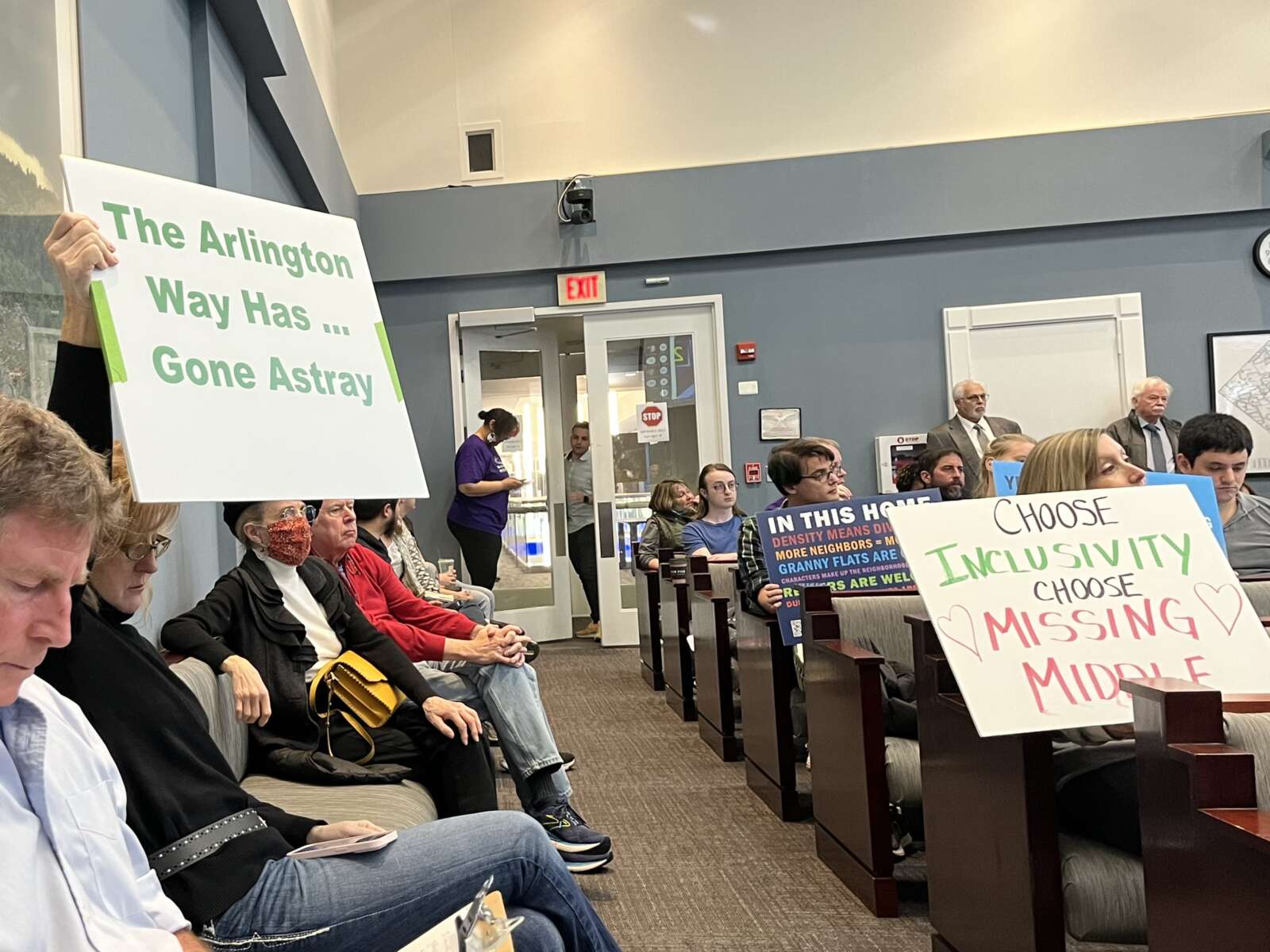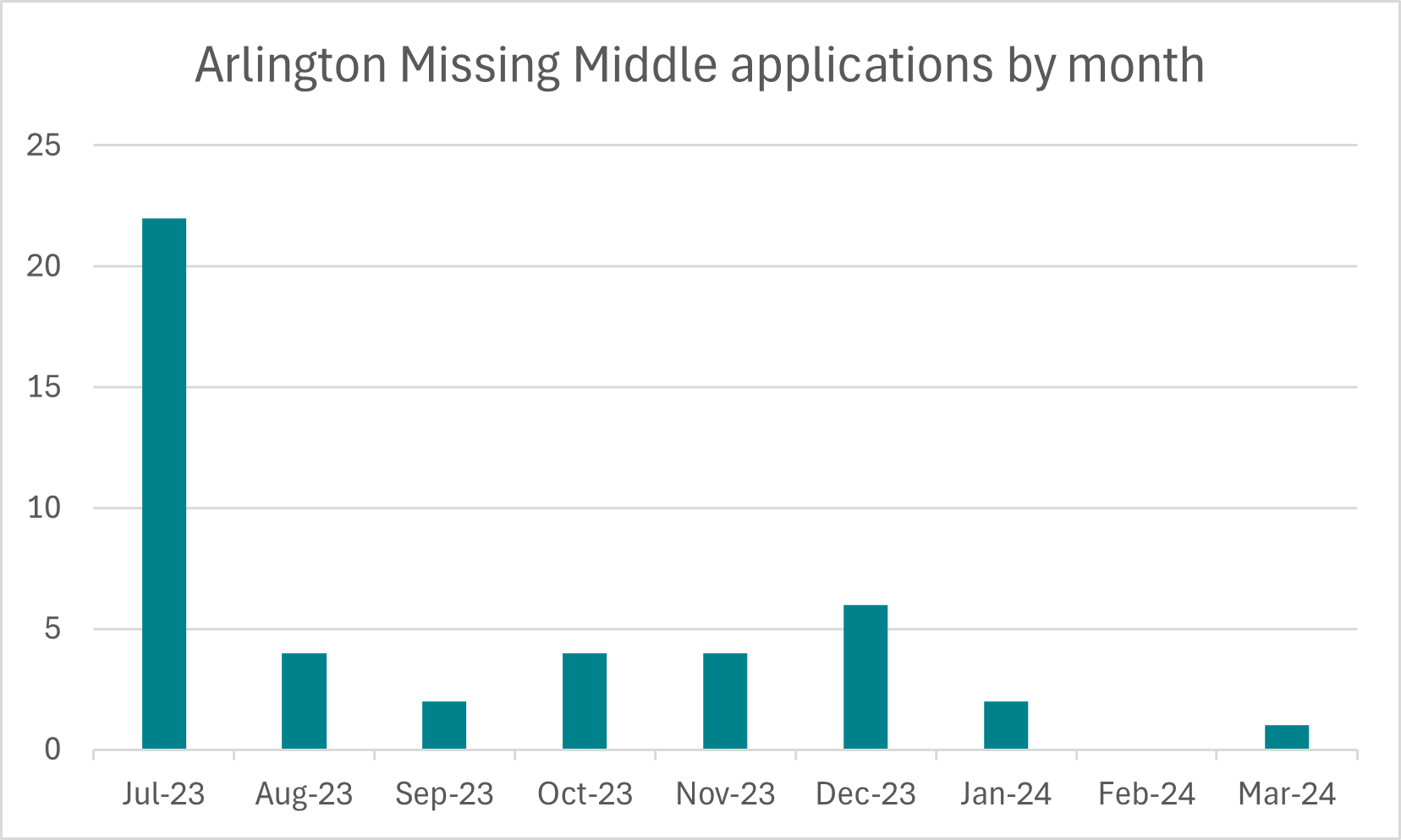
A year after the passage of Arlington’s “Missing Middle” ordinance last March, the jury is out on the long-term implications of the zoning change.
Challenges include a substantial slowdown in Missing Middle applications and continued opposition from some residents.
Gone are the days when a wave of construction applications swept through the county in the wake of the Arlington County Board’s approval of Missing Middle on March 22, 2023.
Instead, development applications involving the Expanded Housing Option have slowed to a relative crawl. The county has approved just three Missing Middle applications since the start of this year, according to its EHO Tracker page.
A pending lawsuit may be at the root of the slowdown, housing experts say, adding too much risk for builders that might have otherwise considered EHO projects.
Additionally, Jane Green, co-founder of YIMBYs of Northern Virginia, argued that remaining zoning restrictions could be playing a role.
But in a Board work session last Thursday, Chair Libby Garvey said the county should be prioritizing solutions to some of the potential negative impacts of more dense housing development.
Long overdue, in Garvey’s view, is a reexamination of the county’s lot coverage policies, which determine what portion of a property can be taken up by housing.
The county has teased a revamp of lot coverage for years as some residents have bemoaned the loss of tree cover to development. Garvey said it is time to follow through.
“I think we absolutely have to do it,” the chair said. “I think some of the upset from our community has somewhat been from that.”
Declining Missing Middle applications
After Missing Middle went into effect last July, in a single month the county received 22 EHO applications — that is, applications to develop smaller multifamily structures in neighborhoods that were previously only single-family detached homes.
Advocates hailed Missing Middle as a historic step toward housing inclusivity, while opponents mourned expected impacts on neighborhoods and the loss of the “Arlington Way” of lengthy, deferential public engagement processes. So far, the change has brought 111 planned units that would house 83 additional households.
At the moment, however, the future of EHO development is murky.
While the county received a handful of EHO applications every month for the last several months of 2023, since the start of this year, applications have been “obviously scraping the bottom,” said Salim Furth, a senior research fellow at the Mercatus Center at George Mason University.
The county received only two Missing Middle applications in January, zero in February and one so far in March.

One possible reason for the trend, Furth said, could be a lawsuit claiming that the County Board illegally approved Missing Middle. This, coupled with ongoing high mortgage rates and market uncertainty, could be deterring additional development.
“Initial decisions in October and early January hung a lot of uncertainty over the heads of applicants,” Furth said, referring to court decisions allowing the lawsuit to move forward. “I certainly wouldn’t buy property in Arlington right now, paying a high interest rate to hold it, in hopes that my investment wouldn’t be destroyed next summer by an unfavorable decision or a multiyear delay.”
As of January, the lawsuit was on track to go to trial in July.
Affordable housing advocate Michelle Winters doesn’t believe the lawsuit is likely to succeed. But she pointed out that if it does, it could throw previously approved projects into jeopardy — possibly even requiring their demolition.
“There’s definitely not waning interest in missing middle housing,” Winters said. “What I think is happening is risk management by developers.”
Green, for her part, blamed the reduction in permitting on the current limits of Missing Middle.
“The ordinance contains many restrictions that make EHO development challenging,” Green said. “I expect many developers will continue to favor the construction of single-family detached homes.”
Green suggested, for instance, that Arlington should have allowed more housing density in transit-accessible neighborhoods like Clarendon.
Finding an answer to lot coverage
While the future of Missing Middle hangs in the balance, some residents argue that the county needs to do more to protect neighborhoods from development they see as undesirable, including the building of large single-family homes.
Nine Arlington civic associations submitted a letter in February imploring the County Board to reexamine the Arlington’s lot coverage guidelines.
“We have been very disappointed in the continuing failure of the County to address this serious issue, at the same time that more and more mature trees are continually destroyed in increasing numbers of teardowns,” wrote civic associations representing Arlington Forest, Ashton Heights, Bluemont, Chain Bridge Forest, Donaldson Run, Glencarlyn, Old Glebe, Rivercrest and Waycroft-Woodlawn.
The Expanded Housing Option creates more ways for developers to abuse lot-coverage restrictions in ways that negatively impact neighborhoods, according to Bill Richardson, president of the Donaldson Run Civic Association.
Richardson’s fight to stop developers from tearing down 100-year-old beech and oak trees, however, predates Missing Middle discussions.
“It is now more important than ever because we have expanded opportunities for these big structures, and it doesn’t matter whether it’s a single-family home or six homes,” Richardson said.
Civic associations have “repeatedly raised this issue with Board Members over the years,” the letter says, and the issue has only become more pressing with time.
“These teardowns now also pose much more extensive stormwater management challenges, with the increasing frequency and severity of storms,” the civic associations said. “Equally important, many of our members have expressed shock at the sheer size and scope of these teardowns, which have led to construction of huge structures that dwarf the homes of their neighbors, in a way that undermines the very purpose of zoning regulation.”
The letter urged the County Board to direct Community Planning, Housing and Development to prioritize lot coverage and to fund a study into the issue in the budget for Fiscal Year 2025. Vice-Chair Takis Karantonis advocated for this approach on Thursday.
“I believe that we would be serving well our community if we began to be operational and intentional,” he said. “Say, ‘Look, we need to look at this. Let’s study that first. Let’s gather some data.”
Garvey, meanwhile, simply said, “I feel really strongly, we’ve got to start it somehow.”
“I really, really want to have that included in our CPHD plan and I’m willing to put in the resources to do it and figure out a way to do it,” she said.

